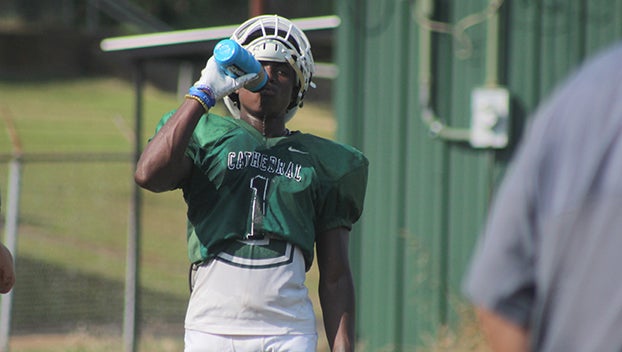Athletes can prevent dehydration through proactive actions
Published 1:50 pm Friday, June 3, 2022

- Cathedral Wide Receiver Tris McCoy takes a drink of water during spring football camp. It is important for athletes to stay hydrated during the summer heat to avoid any medical problems such as heat stroke, heat exhaustion and heat cramps. (Hunter Cloud | The Natchez Democrat)
|
Getting your Trinity Audio player ready...
|
NATCHEZ — Summer heat means athletes should be concerned about their water intake as they train in practice.
Fred Worthy, head athletic trainer at Merit Health Natchez, said it is important to be proactive by hydrating and cooling through shade or cold tubs. People need to keep a balance as over hydrating, called hyponatremia, flushes electrolytes from your blood stream and can cause death.
Wendi Irlbeck, a registered dietitian and certified sports nutritionist with www.nutritionwithwendi.com, said athletes should start by weighing themselves and then drink 17 to 20 ounces of fluid or sports drink two to three hours before a workout. They should consume an additional eight to 12 ounces of fluid, or sports drink 20 to 30 minutes before a workout and eight ounces of fluid every 20 minutes.
After the workout, athletes should weigh themselves and consume 16 to 24 ounces for every pound lost by rehydrating. Worthy added fluids don’t have to be beverages. Fruits such as watermelon are a good way to replenish the body.
“Alabama uses watermelon as a post practice recovery. Not only does it help hydrate, but it aids with muscle soreness,” Worthy said. “Look at what you are eating too if you cramp up after hydrating well. Put a little salt on your fries and use sauces such as ketchup or mustard to bring sodium into your diet. Plain potato chips, and corn chips will help you keep your sodium levels which helps replenish your electrolytes.”
People can replenish or help regulate their electrolyte levels by using electrolyte products found at the grocery store, such as pedialyte, Worthy said. He added people need to do their research and look at the sodium content in what they are consuming. Caffeinated drinks or drinks high in sugar should be avoided as they actually dehydrate an individual..
There are two ways to check for dehydration. He said the first indicator is the color of urine. A darker yellow indicates dehydration, but a lemonade yellow is an indicator of hydration.
Clear urine is an indicator of over hydration. The second indicator is body weight. He said an athlete who can’t replenish the weight lost during a workout is more than likely dehydrated.
Worthy said water doesn’t have to be cold for an athlete to hydrate. If anything, room temperature water will be absorbed by the blood stream more than cold water will. Cold water has a secondary benefit of cooling the body’s core temperature.
According to the Center for Disease Control, dehydration is not the only heat-related ailment athletes must work to prevent. Heat exhaustion causes heavy sweating, cold, pale and clammy skin, dizziness, headaches and nausea.
Athletes should move to a cool place, put on cool wet clothes or towels on their body and sip water. People should seek medical help if they are throwing up, their symptoms get worse, or the symptoms last longer than an hour.
Heat stroke is more severe and could lead to death, Worthy said. Athletes afflicted with heat stroke will have body temperature of 103 degrees or higher, hot, red, rashy or damp skin, a fast strong pulse, headache, dizziness, nausea, and passing out. The CDC says you should provide care to a victim of heat stroke, call 911, move the person to a cool place and help lower the person’s temperature.
“Coaches are there every day, and they need to stay on top of this stuff because at the end of the day, it is their responsibility,” Worthy said. “Be proactive. Don’t wait until it happens.”
He said there are a few ways people can beat the heat besides hydration and staying cool. People can wear sunscreen to lower the risk of sunburns. Sunburns raise the body temperature and prevent sweat glands from working.
In the South, sweat doesn’t evaporate from the skin to help cool you off. Instead you are stuck essentially “swimming in your sweat,” Worthy said.
People should work out in the early mornings or late evenings just before sunset to protect themselves from solar radiation. He said solar radiation compounds the heat index and humidity to cause problems. Heat acclimation is another proactive step to prevent heat related health issues.
“It is why our high school teams are getting out in the heat right now. It is to get used to the heat, so they have less problems with it once the season rolls around,” Worthy said. “The biggest thing is get out of the AC and get acclimated to the heat.”






